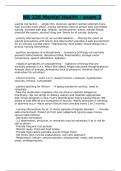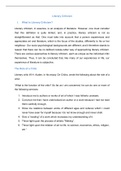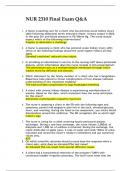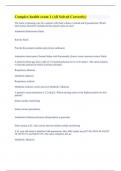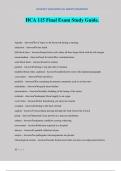NR 326 Mental Health - exam 2
suicide risk factors - -single (2x), divorced, gender (women attempt more,
men succeed more often), having someone close to person who committed
suicide, increase with age, religion, socioeconomic status, mental illness,
stressful life events, alcohol/ drug use, family hx of suicide, bullying
-priority intervention for pt. w/ suicidal ideation - --Placing the client on
suicide precautions with one-to-one observation provides a safe environment
for an actively suicidal client. •Maintaining client safety should always be a
priority nursing intervention.
-positive symptoms of schizophrenia - -(presence of things not normally
present) hallucinations, delusions (false, fixed beliefs), strange motor
movements, speech alterations, agitation.
-negative symptoms of schizophrenia - -(absence of things that are
normally present) 5 A's: Affect (flat affect) Alogia (decrease thought/speech),
Anergia (lack of energy), Anhedonia (lack of pleasure), Avolition (lack of
motivation for activities)
-Lithium toxicity - -toxic >1.5: coarse tremors, confusion, hypotension,
seizures, tinnitus, coma/death
-patient teaching for lithium - --if going outside for activity, need to
rehydrate
-Take the medication regularly.•Do not drive or operate dangerous
machinery.•Do not skimp on dietary sodium and maintain appropriate
diet.•Know pregnancy risks.•Carry identification noting taking lithium.•Be
aware of side effects and symptoms of toxicity.•Notify physician if vomiting
or diarrhea occur.•Have serum lithium level checked every 1 to 2 months.
-nursing intervention for pt. in manic episode of bipolar disorder - -· Provide
safe environment. Protect pt from poor judgement (giving away money,
sexual indiscretions)
· Decrease stimulation
· 1:1 observation, seclusion, or restraints may be necessary if pt is risk for
self or others
· Provide frequent rest periods
· Monitor sleep, fluid and food intake.
· Provide high-calorie portable snacks (finger food)
· Set limits, give concise explanations, use calm approach
· Medications: lithium, anticonvulsants, antipsychotic meds, anti-anxiety
meds, antidepressants.
, -bipolar mania - -excessively elevated mood, lasting more than a week.
-MAOI's (what not to eat) - -No tyramine foods
-core of OCD - -anxiety
-s/s of PTSD - -Flashbacks, distressing dreams, difficulty concentrating,
insomnia, anxiety, irritability, detachment from others, hypervigilance,
exaggerated startle response, feeling of guilt and negative self image.
-pt. attempts suicide (even if only once) - -pt. put at high suicide risk
immediately initiated
-extrapyramidal EPS - -· dystonia, Parkinson's symptoms, tardive dyskinesia
(lip smacking, tongue rolling) akathisia (muscle quivering, restlessness)
-Neuroleptic malignant syndrome - -Adverse reaction to antipsychotics
-Neuroleptic malignant syndrome (s/s) - -fever, dysrhythmias, BP
fluctuations, muscle rigidity
-word salad - -words are jumbled together in meaningless way
-Neologisms - -made-up words that only the pt understands
-Flights of ideas - -each sentence relates to a different topic. Listener
unable to follow pt thoughts
-Echolalia - -pt repeats exactly what is said to him
-Clang association - -meaningless rhyming of words
-interventions for pt w/ depression - -give pt. time to gather thoughts and
decide what they want to say
-nursing assessment of suicidal pt. - --Ask questions ( how serious is the
intent? Do you have a plan?)
-Verbal cues: I want to die!, This is the last time you will see me, I wont be
around much longer for the doctor to have to worry about, or I don't have
anything worth living for anymore.
-Coping strategies: how did you handle previous crisis? How is this different
from other crisis?
-interventions for pt. not wanting to take meds - -decanoate (long term
injection of haldol)
suicide risk factors - -single (2x), divorced, gender (women attempt more,
men succeed more often), having someone close to person who committed
suicide, increase with age, religion, socioeconomic status, mental illness,
stressful life events, alcohol/ drug use, family hx of suicide, bullying
-priority intervention for pt. w/ suicidal ideation - --Placing the client on
suicide precautions with one-to-one observation provides a safe environment
for an actively suicidal client. •Maintaining client safety should always be a
priority nursing intervention.
-positive symptoms of schizophrenia - -(presence of things not normally
present) hallucinations, delusions (false, fixed beliefs), strange motor
movements, speech alterations, agitation.
-negative symptoms of schizophrenia - -(absence of things that are
normally present) 5 A's: Affect (flat affect) Alogia (decrease thought/speech),
Anergia (lack of energy), Anhedonia (lack of pleasure), Avolition (lack of
motivation for activities)
-Lithium toxicity - -toxic >1.5: coarse tremors, confusion, hypotension,
seizures, tinnitus, coma/death
-patient teaching for lithium - --if going outside for activity, need to
rehydrate
-Take the medication regularly.•Do not drive or operate dangerous
machinery.•Do not skimp on dietary sodium and maintain appropriate
diet.•Know pregnancy risks.•Carry identification noting taking lithium.•Be
aware of side effects and symptoms of toxicity.•Notify physician if vomiting
or diarrhea occur.•Have serum lithium level checked every 1 to 2 months.
-nursing intervention for pt. in manic episode of bipolar disorder - -· Provide
safe environment. Protect pt from poor judgement (giving away money,
sexual indiscretions)
· Decrease stimulation
· 1:1 observation, seclusion, or restraints may be necessary if pt is risk for
self or others
· Provide frequent rest periods
· Monitor sleep, fluid and food intake.
· Provide high-calorie portable snacks (finger food)
· Set limits, give concise explanations, use calm approach
· Medications: lithium, anticonvulsants, antipsychotic meds, anti-anxiety
meds, antidepressants.
, -bipolar mania - -excessively elevated mood, lasting more than a week.
-MAOI's (what not to eat) - -No tyramine foods
-core of OCD - -anxiety
-s/s of PTSD - -Flashbacks, distressing dreams, difficulty concentrating,
insomnia, anxiety, irritability, detachment from others, hypervigilance,
exaggerated startle response, feeling of guilt and negative self image.
-pt. attempts suicide (even if only once) - -pt. put at high suicide risk
immediately initiated
-extrapyramidal EPS - -· dystonia, Parkinson's symptoms, tardive dyskinesia
(lip smacking, tongue rolling) akathisia (muscle quivering, restlessness)
-Neuroleptic malignant syndrome - -Adverse reaction to antipsychotics
-Neuroleptic malignant syndrome (s/s) - -fever, dysrhythmias, BP
fluctuations, muscle rigidity
-word salad - -words are jumbled together in meaningless way
-Neologisms - -made-up words that only the pt understands
-Flights of ideas - -each sentence relates to a different topic. Listener
unable to follow pt thoughts
-Echolalia - -pt repeats exactly what is said to him
-Clang association - -meaningless rhyming of words
-interventions for pt w/ depression - -give pt. time to gather thoughts and
decide what they want to say
-nursing assessment of suicidal pt. - --Ask questions ( how serious is the
intent? Do you have a plan?)
-Verbal cues: I want to die!, This is the last time you will see me, I wont be
around much longer for the doctor to have to worry about, or I don't have
anything worth living for anymore.
-Coping strategies: how did you handle previous crisis? How is this different
from other crisis?
-interventions for pt. not wanting to take meds - -decanoate (long term
injection of haldol)

